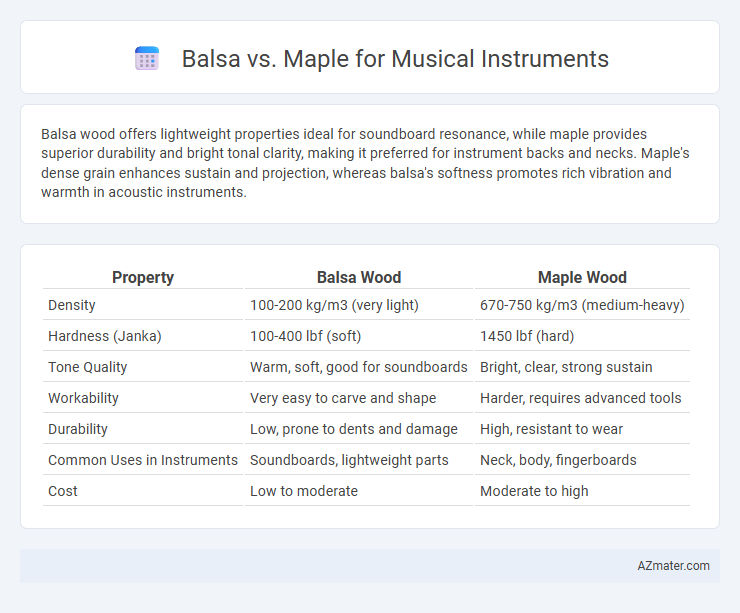Balsa wood offers lightweight properties ideal for soundboard resonance, while maple provides superior durability and bright tonal clarity, making it preferred for instrument backs and necks. Maple's dense grain enhances sustain and projection, whereas balsa's softness promotes rich vibration and warmth in acoustic instruments.
Table of Comparison
| Property | Balsa Wood | Maple Wood |
|---|---|---|
| Density | 100-200 kg/m3 (very light) | 670-750 kg/m3 (medium-heavy) |
| Hardness (Janka) | 100-400 lbf (soft) | 1450 lbf (hard) |
| Tone Quality | Warm, soft, good for soundboards | Bright, clear, strong sustain |
| Workability | Very easy to carve and shape | Harder, requires advanced tools |
| Durability | Low, prone to dents and damage | High, resistant to wear |
| Common Uses in Instruments | Soundboards, lightweight parts | Neck, body, fingerboards |
| Cost | Low to moderate | Moderate to high |
Introduction to Balsa and Maple in Instrument Making
Balsa and maple are distinct woods commonly used in musical instrument making, each offering unique acoustic properties and workability. Balsa, known for its lightweight and soft texture, provides excellent resonance and is often used for internal components or lightweight parts of stringed instruments. Maple, a dense hardwood with a bright tone and strong structural integrity, is favored for instrument backs, necks, and fingerboards, contributing to durability and a crisp, clear sound.
Physical Properties: Balsa vs Maple
Balsa wood, with its low density of approximately 160 kg/m3, offers exceptional lightness and excellent sound absorption, making it ideal for components requiring minimal weight. Maple wood, significantly denser at around 700 kg/m3, provides superior strength, durability, and bright tonal quality, commonly favored for guitar necks and fingerboards. The contrasting stiffness-to-weight ratios influence resonance and sustain, where maple's hardness supports crisp attack while balsa's softness contributes to warm, muted tones.
Weight and Density Comparison
Balsa wood, with a density ranging between 160-320 kg/m3, is significantly lighter than maple, which has a density of approximately 600-750 kg/m3, making balsa ideal for instruments requiring lightweight components. The low density of balsa contributes to enhanced resonance and ease of handling, while maple's higher density offers superior durability and a brighter tonal quality. Choosing between balsa and maple depends on the desired balance between weight reduction and acoustic performance in musical instrument construction.
Tonal Characteristics of Balsa and Maple
Balsa wood produces warm, soft tonal qualities with a light, airy resonance ideal for acoustic instruments seeking enhanced sustain and subtle overtones. Maple offers a bright, clear sound characterized by strong midrange presence and well-defined high frequencies, contributing to punchy and articulate tonal clarity in both electric and acoustic instruments. The choice between balsa and maple significantly impacts the instrument's tonal projection, with balsa favoring mellow warmth and maple delivering crisp brightness.
Durability and Longevity in Musical Instruments
Maple offers superior durability and longevity compared to balsa, making it a preferred choice for musical instruments that require strength and resilience, such as guitars and violins. Balsa's lightweight nature benefits sound resonance but lacks the hardness to withstand frequent handling or environmental stress over time. Instruments crafted from maple maintain structural integrity longer, preserving sound quality and playability through years of use.
Workability for Luthiers and Craftsmen
Maple offers superior workability for luthiers due to its fine grain and dense structure, allowing precise carving and detailed inlays essential for high-quality musical instruments. Balsa, being extremely lightweight and soft, is easier to shape but lacks the structural strength and durability required for most musical instrument components. Craftsmen often prefer maple for necks and backs where stability and tonal qualities are critical, while balsa is mainly used for internal bracing or lightweight parts where rigidity is less demanding.
Cost and Availability
Balsa wood is significantly more affordable and widely available compared to maple, making it a popular choice for budget-conscious musicians and mass production. Maple, prized for its density and tonal qualities, commands a higher price and is sourced primarily from temperate regions, which can limit availability depending on geographic location. The cost differential influences instrument makers to select balsa for lightweight, cost-effective designs, while maple is favored for high-end instruments requiring durability and superior sound projection.
Popular Instrument Applications for Balsa and Maple
Balsa wood is prized in musical instrument making for its lightweight and resonance, commonly used in ukuleles and lightweight acoustic guitars, where enhanced sound projection and ease of play are essential. Maple, known for its density and bright tonal qualities, is frequently employed in violins, cellos, and electric guitar bodies, providing durability and a crisp, clear sound ideal for both classical and contemporary music styles. The choice between balsa and maple significantly influences the instrument's tonal character and playability, with balsa favoring softer, mellow sounds and maple delivering sharper, more articulate tones.
Sound Quality and Resonance Differences
Balsa wood offers exceptional resonance and a warm, airy tone due to its low density, making it ideal for instruments like ukuleles and lightweight guitars where sound projection and clarity are desired. Maple, denser and harder, provides brighter, more focused sound with greater sustain, often favored for violins, cellos, and electric guitar bodies to enhance tonal brightness and articulation. The distinct grain structure of maple contributes to enhanced vibration transfer and crisp sound quality, while balsa's porous nature results in softer attack and richer harmonic overtones.
Choosing the Right Wood for Your Musical Instrument
Balsa wood offers exceptional lightness and resonance, making it ideal for instruments requiring agile sound production and portability, whereas maple provides superior hardness and durability, delivering a bright, clear tone favored for guitars and violins. Selecting the right wood depends on the desired tonal quality and structural strength; maple enhances sustain and projection, while balsa emphasizes warmth and ease of play. Both woods impact the instrument's acoustic performance and aesthetic, influencing sound clarity, resonance frequency, and overall craftsmanship.

Infographic: Balsa vs Maple for Musical Instrument
 azmater.com
azmater.com